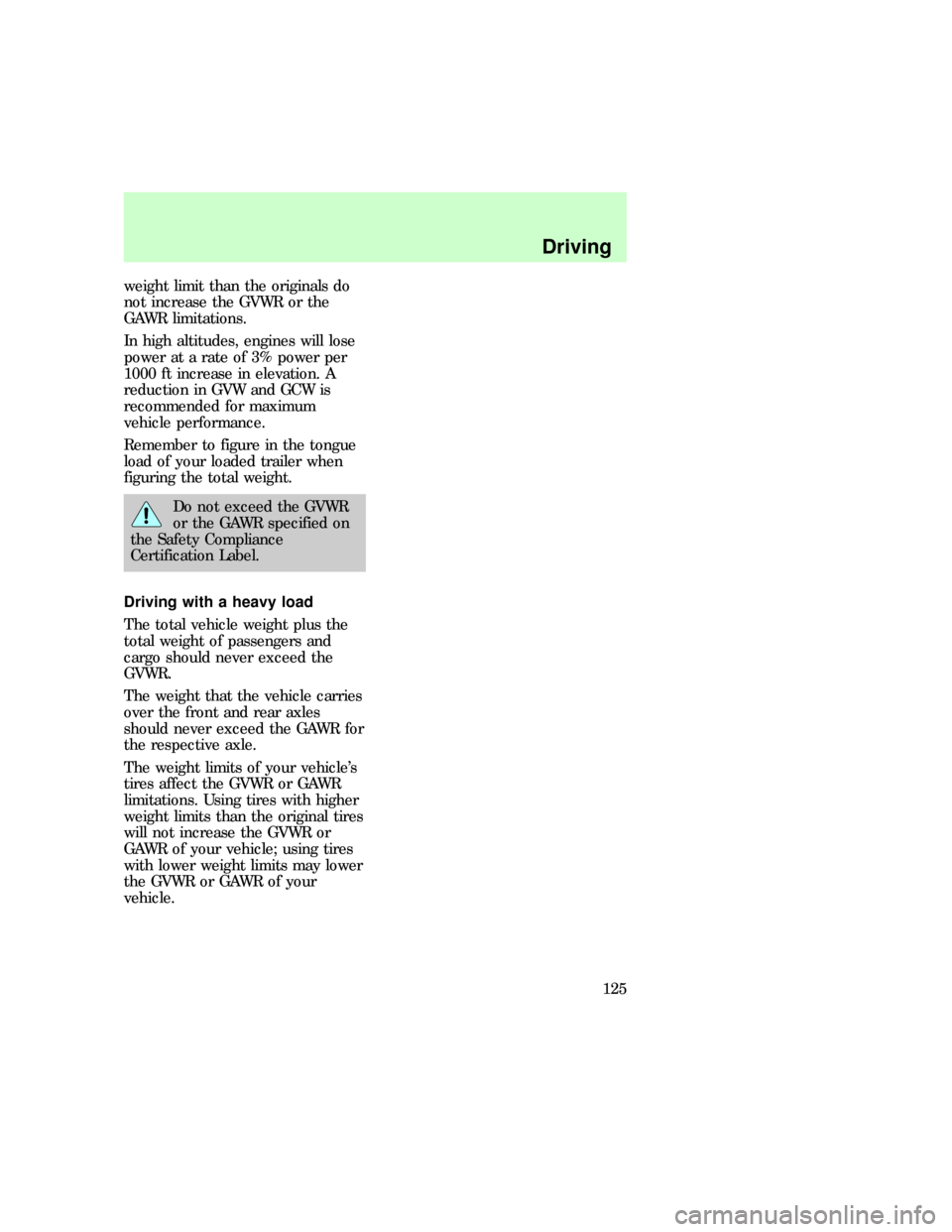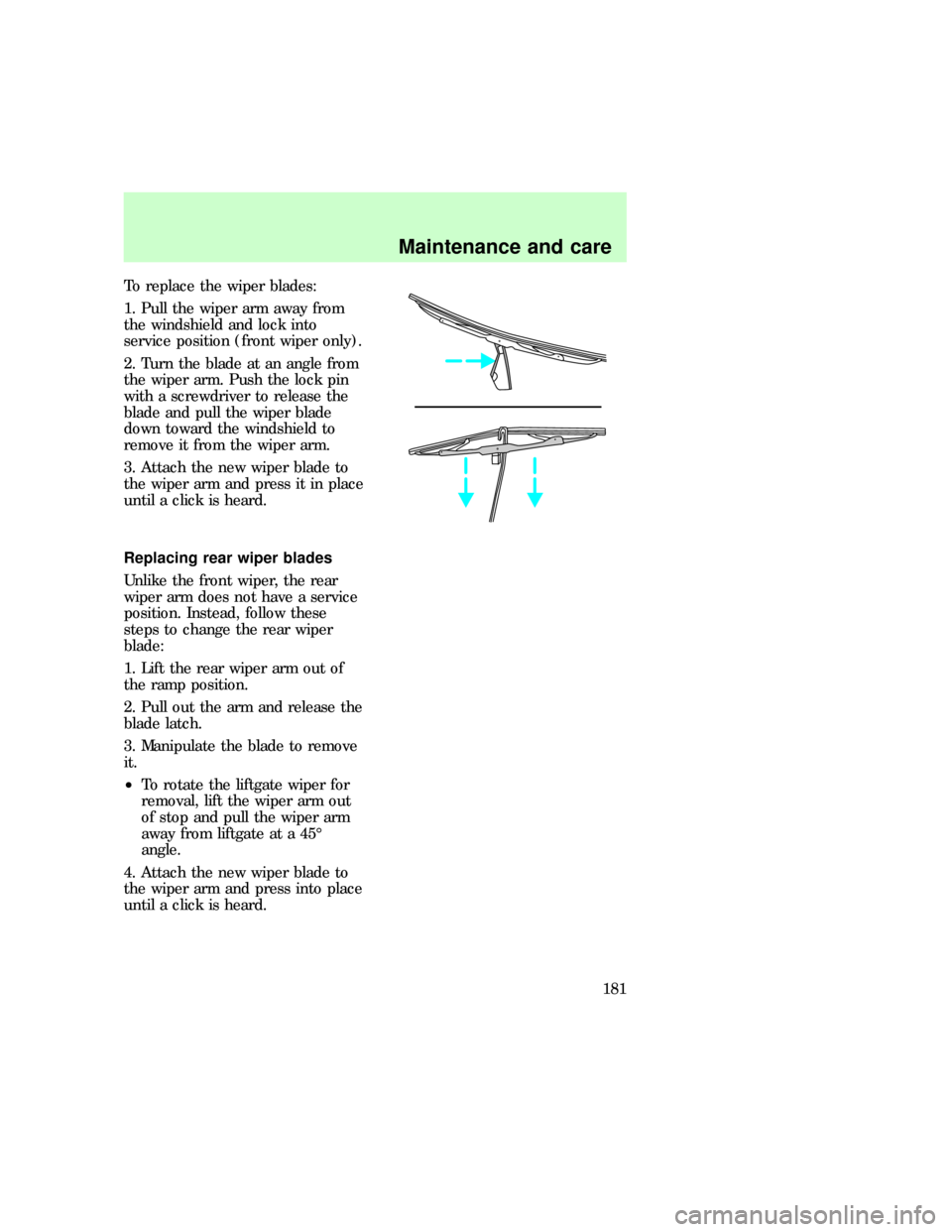Page 110 of 224

UNDERSTANDING THE
TRACTION-LOKTREAR AXLE
(IF EQUIPPED)
This axle provides added traction
on slippery surfaces, particularly
when one or more wheels are on a
surface with poor traction.
Extended use of other than
matching size tires on a
Traction-Loktrear axle could
result in a permanent reduction in
effectiveness. This loss of
effectiveness does not affect
normal driving and should not be
noticeable to the driver.
To avoid injury, never run
the engine with one wheel
off the ground, such as when
changing a tire.
AIR SUSPENSION SYSTEM (IF
EQUIPPED)
The air suspension system is
designed to improve ride, handling
and general vehicle performance
for static, on and off road driving
conditions.
The load leveling feature of the air
suspension system automatically
keeps the vehicle at a constant
level if a load is added or removed
from the vehicle.
The height adjustment feature
(4x4 air suspension system only)
automatically controls the vehicle
height over a range of
approximately 5 cm (2 in) based
on vehicle speed, ignition position
exd_air_suspension
Driving
111
Page 123 of 224

Rating):Carrying capacity for
each axle system (front and
rear). The GAWR is specific to
each vehicle and is listed on the
Safety Compliance Certification
Label on the driver's door.
²GCWR (Gross combined weight
rating ):Maximum combined
weight of the towing vehicle
(including passengers and
cargo) and the trailer. The
GCWR indicates the maximum
loaded weight that the vehicle is
allowed to tow.
²Maximum trailer weight:
Maximum weight of a trailer the
loaded vehicle (including
passengers and cargo) is
permitted to tow. It is
determined by subtracting the
weight of the loaded towing
vehicle from the GCWR of the
towing vehicle.
²Trailer weight range:Specified
weight range that the trailer
must fall within that ranges from
zero to the maximum trailer
weight rating.
Payload = GVWR minus Base
curb weight
To obtain the correct weights for
your vehicle, try taking your
vehicle to a shipping company or
an inspection station for trucks.
Do not use replacement tires with
lower weight capacities than the
originals because they might lower
the vehicle's GVWR and GAWR.
Replacement tires with a higher
Driving
124
Page 124 of 224

weight limit than the originals do
not increase the GVWR or the
GAWR limitations.
In high altitudes, engines will lose
power at a rate of 3% power per
1000 ft increase in elevation. A
reduction in GVW and GCW is
recommended for maximum
vehicle performance.
Remember to figure in the tongue
load of your loaded trailer when
figuring the total weight.
Do not exceed the GVWR
or the GAWR specified on
the Safety Compliance
Certification Label.
Driving with a heavy load
The total vehicle weight plus the
total weight of passengers and
cargo should never exceed the
GVWR.
The weight that the vehicle carries
over the front and rear axles
should never exceed the GAWR for
the respective axle.
The weight limits of your vehicle's
tires affect the GVWR or GAWR
limitations. Using tires with higher
weight limits than the original tires
will not increase the GVWR or
GAWR of your vehicle; using tires
with lower weight limits may lower
the GVWR or GAWR of your
vehicle.
exd_driving_heavy_load
exd_luggage_rack
Driving
125
Page 126 of 224
TRAILER TOWING
Trailer towing with your vehicle
may require the use of a trailer
tow option package.
Trailer towing puts additional loads
on your vehicle's engine,
transmission, axle, brakes, tires,
and suspension. For your safety
and to maximize vehicle
performance, be sure to use the
proper equipment while towing.
Follow these guidelines to ensure
safe towing procedure:
²Stay within your vehicle's load
limits.
²Thoroughly prepare your vehicle
for towing. Refer toPreparing
to towin this chapter.
²Use extra caution when driving
while trailer towing. Refer to
Driving while towingin this
chapter.
²Service your vehicle more
frequently if you tow a trailer.
Refer to the severe duty
schedule in the ªService Guideº.
²Do not tow a trailer until your
vehicle has been driven at least
800 km (500 miles).
²Refer to the instructions
included with towing accessories
for the proper installation and
adjustment specifications.
Driving
127
Page 143 of 224

CHANGING THE TIRES
If you get a flat tire while driving,
do not apply the brake heavily.
Instead, gradually decrease your
speed. Hold the steering wheel
firmly and slowly move to a safe
place on the side of the road:
²Park on a level spot.
²Turn off the ignition.
²Set the parking brake.
²Activate the hazard flashers.
Spare tire information
Your vehicle is equipped with a
spare tire that may be used as a
spare or as a regular tire. The
spare is identical to the other tires
on your vehicle, although the
wheel cover may not match.
Location of the spare tire and
tools
The spare tire and tools for your
vehicle are stowed in the following
locations:
Tool Location
Spare tire Under the vehicle, just in front of the rear
bumper.
Jack, wheel nut
wrench, instructions,
work glovesBehind the access panel located on the right
rear quarter panel interior trim.
Jack handle On the top of the raditator support at the front
of the engine compartment.
exd_flat-tires_changing
exd_spare_location
exd_location_spare_tools
Roadside emergencies
144
Page 175 of 224
TRACTION-LOK REAR AXLE (IF
EQUIPPED)
This axle provides added drive
away traction on slippery surfaces,
particularly when one or more
wheels are on a surface with poor
traction.
Extended use of other than
matching size tires on a
Traction-Lok rear axle could result
in a permanent reduction in
effectiveness. This loss of
effectiveness does not effect
normal driving and should not be
noticeable to the driver.
To avoid injury, never run
the engine with one wheel
off the ground, such as when
changing a tire.
BATTERY
If the original equipment
maintenance-free battery needs
replacing, it may be replaced with
a low-maintenance battery. For
information on replacement
batteries, refer toMotorcraft part
numbersin theCapacities and
specificationschapter.
The gases around the
battery can explode if
exposed to flames, sparks, or lit
cigarettes. An explosion could
result in injury or vehicle
damage.
exd_battery
Maintenance and care
176
Page 180 of 224

To replace the wiper blades:
1. Pull the wiper arm away from
the windshield and lock into
service position (front wiper only).
2. Turn the blade at an angle from
the wiper arm. Push the lock pin
with a screwdriver to release the
blade and pull the wiper blade
down toward the windshield to
remove it from the wiper arm.
3. Attach the new wiper blade to
the wiper arm and press it in place
until a click is heard.
Replacing rear wiper blades
Unlike the front wiper, the rear
wiper arm does not have a service
position. Instead, follow these
steps to change the rear wiper
blade:
1. Lift the rear wiper arm out of
the ramp position.
2. Pull out the arm and release the
blade latch.
3. Manipulate the blade to remove
it.
²To rotate the liftgate wiper for
removal, lift the wiper arm out
of stop and pull the wiper arm
away from liftgate at a 45É
angle.
4. Attach the new wiper blade to
the wiper arm and press into place
until a click is heard.
exd_rear_wiper_replace
exd_maint-tires
Maintenance and care
181
Page 181 of 224

IMPORTANT TIRE
MAINTENANCE INFORMATION
Information about tire quality
grades
New vehicles are fitted with tires
that have their Tire Quality Grade
(described below) molded into the
tire's sidewall. These Tire Quality
Grades are determined by
standards that the United States
Department of Transportation has
set.
Tire Quality Grades apply to new
pneumatic tires for use on
passenger cars. They do not apply
to deep tread, winter-type snow
tires, space-saver or temporary use
spare tires, tires with nominal rim
diameters of 10 to 12 inches or
limited production tires as defined
in Title 49 Code of Federal
Regulations Part 575.104(c)(2).
U.S. Department of
Transportation-Tire quality
grades:The U.S. Department of
Transportation requires Ford to
give you the following information
about tire grades exactly as the
government has written it.
Treadwear
The treadwear grade is a
comparative rating based on the
wear rate of the tire when tested
under controlled conditions on a
specified government test course.
For example, a tire grade 150
would wear one and one-half (1
1/2) times as well on the
government course as a tire grade
com_about_tire_grades.01
com_treadwear.01
Maintenance and care
182